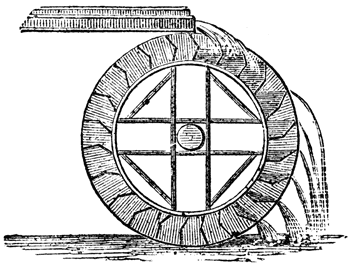|

Courtesy Florida Center for Instructional Technology Clipart ETC
The "Water wheel" model of heat engines.
Note: Both Kelvin and Carnot, The authors of the cited works, expressed doubts whether the "heat is an imponderable indestructible fluid" model properly explained available experimental data at the time "Reflections on the Motive Power of Heat” was being written. The fluid model was ultimately supplanted as the dominant paradigm by modeling heat as molecular motion just twenty years later. The "motion" model of heat has stood the test of time through the present day.
|
How Very Quaint!
In "Reflections on the Motive Power of Heat" by Sadi Carnot , and "An Account of Carnot's Theory" by Sir William Thomson (better known as Lord Kelvin) (Kelvin scale anyone?) Thanks to www.archive.org for pdf of original scan (Cited as "Reflections" for brevity hereafter).
Pg 46 (Carnot)
The production of motive power is then due in
steam-engines not to an actual consumption of
caloric, but to its transportation from a warm
body to a cold body, that is, to its re-establishment
of equilibrium an equilibrium considered as destroyed
by any cause whatever, by chemical action
such as combustion, or by any other. We shall
see shortly that this principle is applicable to
any machine set in motion by heat.
According to this principle, the production of
heat alone is not sufficient to give birth to the
impelling power: it is necessary that there should
also be cold; without it, the heat would be useless.
According to this principle, the production of
heat alone is not sufficient to give birth to the
impelling power: it is necessary that there should
also be cold; without it, the heat would be useless.
And in fact, if we should find about us
only bodies as hot as our furnaces, how can we
condense steam ? What should we do with it if
once produced ? We should not presume that we
might discharge it into the atmosphere, as is done
(pg 47)
in some engines;* the atmosphere would not receive
it. It does receive it under the actual condition
of things, only because it fulfils the office
of a vast condenser, because it is at a lower temperature;
otherwise it would soon become fully
charged, or rather would be already saturated,
Paraphrased (Carnot) Heat is not consumed, but must flow to cold to produce motion.
Pg 60 (Carnot)
According to established principles at the present
time, we can compare with sufficient accuracy the
motive power of heat to that of a waterfall. Each
has a maximum that we cannot exceed, whatever
may be, on the one hand, the machine which is
acted upon by the water, and whatever, on the
other hand, the substance acted upon by the heat.
The motive power of a waterfall depends on its
height and on the quantity of the liquid; the
motive power of heat depends also on the quantity
of caloric used, and on what may be termed, on
what in fact we will call, the height of its fall,
that is to say, the difference of temperature of the
bodies between which the exchange of caloric is
made. In the waterfall the motive power is exactly
proportional to the difference of level between
the higher and lower reservoirs. In the fall of
caloric the motive power undoubtedly increases
with the difference of temperature between the
warm and the cold bodies ; but we do not know
whether it is proportional to this difference. We
do not know, for example, whether the fall of caloric
from 100 to 50 degrees furnishes more or less
motive power than the fall of this same caloric from
50 to zero. It is a question which we propose to
examine hereafter.
Paraphrased (Carnot) The amount of work you get depends on "height of its fall".
Pg 191 (Kelvin)
54. In the use of water-wheels for motive power,
the economy of the engine depends not only upon
the excellence of its adaptation for actually transmitting
any given quantity of water through it,
and producing the equivalent of work, but upon
turning to account the entire available fall; so, as
we are taught by Carnot, the object of a thermodynamic
engine is to economize in the best possible
way the transference of all the heat evolved, from
bodies at the temperature of the source, to bodies
at the lowest temperature at which the heat can be
discharged. With reference, then, to any engine of
the kind, there will be two points to be considered:
(1) The extent of the fall utilized.
(2) The economy of the engine, with the fall
which it actually uses.
Paraphrased (Kelvin) The amount of work you get depends on how much the heat "falls".
|

